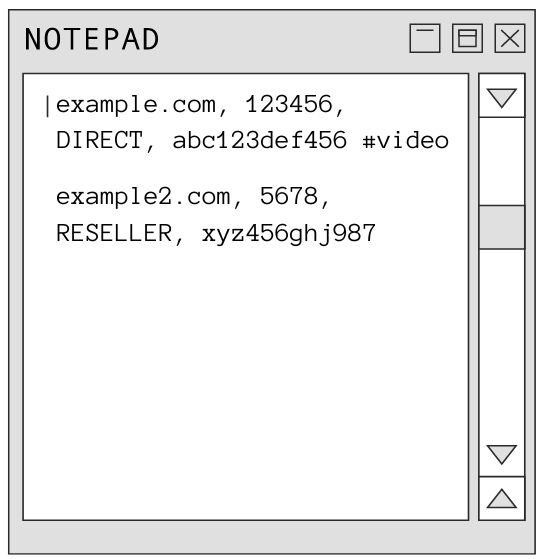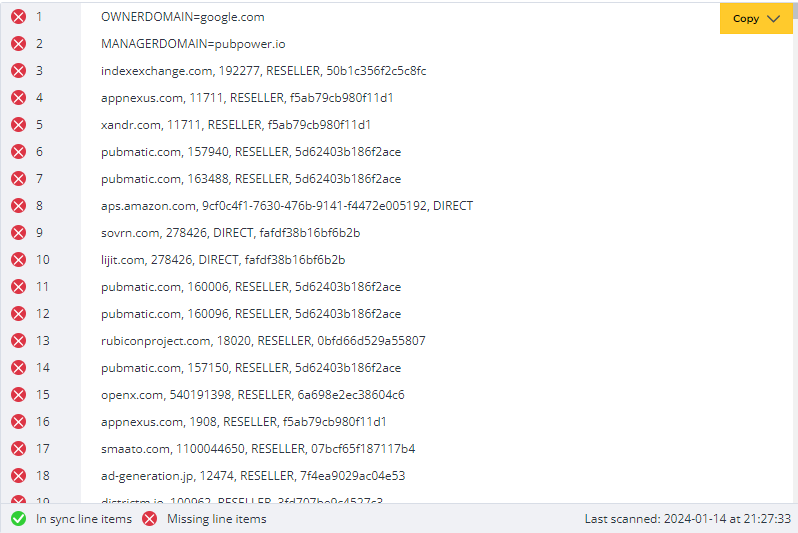Contents
What is ads.txt ? How Can Publishers Implement On Their Website
Programmatic advertising is showing its predominance and potential to become the future of the advertising industry. According to Statista, global programmatic ad spend reached an estimated 558 billion U.S. dollars in 2023, and is predicted to surpass 700 billion by 2026. Nevertheless, alongside this growth comes the persistent threat of ad fraud, which continues to plague the industry. According to recent studies, ad fraud costs advertisers $84 billion of ad spend lost in 2023. Therefore, Ads.txt, an abbreviation for Authorized Digital Sellers, came across, represents a collaborative effort by the Interactive Advertising Bureau (IAB) to combat ad fraud and promote accountability within the ecosystem. In this article, we’re going to have a deeper look into what ads.txt is and how it works.
What is Ads.txt?
Ads.txt, short for Authorized Digital Sellers, is an IAB (Interactive Advertising Bureau) initiative introduced in 2017. It is a simple, flexible, and secure method that publishers can use to declare who is authorized to sell their digital inventory. The file, typically hosted on a publisher’s domain, lists the authorized sellers of the publisher’s advertising inventory. This list can include exchanges, SSPs (Supply-Side Platforms), and other platforms authorized to sell their inventory.
You can think of Ads.txt as the digital advertising industry’s security guard, stationed at the entrance of a bustling marketplace. Just as a security guard verifies the credentials of vendors before allowing them to set up their stalls, Ads.txt verifies the legitimacy of sellers before granting them access to sell ad inventory. By scrutinizing each seller’s credentials and ensuring they are authorized, Ads.txt acts as a vigilant guardian, protecting advertisers from the counterfeit goods of ad fraudsters and preserving the integrity of the marketplace.
Ads.txt 1.1
The main change in ads.txt 1.1 is the introduction of MANAGERDOMAIN & OWNERDOMAIN values.
- The domain name MANAGERDOMAIN refers to the company that manages the inventory on behalf of the owner.
- OWNERDOMAIN refers to the domain name of the company owning the inventory.
These two fields help stop ad fraud & domain spoofing by allowing buyers to purchase inventory from authorized sellers.
Ads.txt Syntax

- Field 1: Domain Name (required): Specifies the domain name of the advertising system authorized to sell the publisher’s inventory such as pubpower.io, pubmatic.com, magnite.com, etc.
- Field 2: Publisher Account ID (required): Specifies the publisher’s account ID within the advertising system. This ID uniquely identifies the publisher’s inventory.
- Field 3: Type of Relationship (required): Indicates the type of relationship between the publisher and the advertising system. Common values include “DIRECT” for direct sellers that have a direct business relationship with the publisher to sell their ad inventory, and “RESELLER” for intermediaries or re-sellers that are authorized to sell ad inventory on behalf of the publisher but do not have a direct business relationship with the publisher.
- Field 4: Certification Authority ID (optional): Specifies the ID of the organization that has certified the relationship between the publisher and the advertising system. This field is optional but recommended for increased transparency and trust.
- Field 5: Comment (optional) Some publishers include this extra field so they know which type of inventory the AdTech vendor sells. As this hashtag represents a comment, it won’t be picked up by the crawling script unless certain configurations are made to it, but as this is purely for the publisher’s benefit, there’s no real need for buyers to have this information.
Example:
example.com, 12345, DIRECT, abc123def456 #video
example.com, 67890, RESELLER, 789xyz456abc #premium video demand
How Does Ads.txt Work?
The implementation of Ads.txt involves publishers creating a text file that contains information about the entities authorized to sell their ad inventory. This file is placed on the root level of the publisher’s domain. Ad buyers can then crawl these files to verify the authenticity of the inventory being sold through various channels.
Here’s a simplified breakdown of the process:
Step 1: Publisher Creates Ads.txt File: Publishers compile a list of authorized sellers including exchanges, SSPs, and other platforms and create a text file named ads.txt.
Step 2: Ads.txt File Placement: The ads.txt file is placed in the root directory of the publisher’s domain (e.g., example.com/ads.txt).
Step 3: Buyer Verification: Ad buyers use web crawlers or other automated tools to access the ads.txt files of publishers they are interested in purchasing inventory from. They verify the authenticity of the sellers listed in the file.
Step 4: Authorized Transactions: Advertisers only buy inventory from sellers listed as authorized in the ads.txt file, reducing the risk of purchasing fraudulent or misrepresented inventory.
Challenges and Considerations
While Ads.txt has been widely adopted and proven effective in combating ad fraud, it is not without its challenges:
- Implementation Complexity: Some publishers may find the implementation of Ads.txt challenging, especially those with limited technical resources. However, PubPower’s header bidding platform has tools and resources available to simplify the process.
- Enforcement and Compliance: Ensuring widespread adoption and compliance with Ads.txt across the industry remains a challenge. While many reputable publishers and ad platforms have embraced Ads.txt, there are still instances of non-compliance and fraudulent activity.
- Evolution of Ad Tech: As the digital advertising landscape continues to evolve, new technologies and techniques may emerge that require ongoing adaptation and refinement of initiatives like Ads.txt to remain effective.
What If I don’t implement ads.txt?
Ads.txt is not mandatory, if you don’t implement this file, you will still be able to sell ad impressions, since many advertisers buy through exchanges and networks that aren’t thorough or strict. But if you’re competing for top quality ads (and their ad dollars), it’s highly recommended. It can help buyers identify counterfeit inventory and help you receive more advertiser spend that might have otherwise gone toward that counterfeit inventory.
You can learn how to create an ads.txt file here!
Ads.txt on PubPower platform
you can redirect your ads.txt to ours.
In the Supply section, at the “Ads.txt” column,you can check status “ In Sync” or Not In Sync”
clicking on the setting icon, at the “Ads.txt” column, , we show you 3 ways to redirect your ads.txt to ours with the detailed instruction, you can refer to it. It’s very simple and easy to do.
Option 1: Setup your ads.txt file directly
The following lines must be included in your site’s ads.txt file so you can sell your inventory to all demands partner. Please update your ads.txt file to include the missing line items.

Option 2: Use PubPower ads.txt management
You can check this instruction for adding PubPower ads.txt lines
Option 3:
Redirect your current Ads.txt file to let PubPower update your ads.txt

You also can redirect your ads.txt to our URL above, so, when we have any updates on our own ads.txt lines, your website will be updated automatically.
In the Ads.txt Manager section, at the “Action” column, clicking on the paper icon, we show you 3 ways to redirect your ads.txt to ours with detailed instructions, you can refer to it. It’s very simple and easy to do.

After updating our ads.txt, after 24 hours, you also can check your missing lines (if any) on the dashboard, in the Ads.txt Manage tab.
Check out this instruction to add PubPower ads.txt lines.

In summary
Ads.txt stands as a beacon of transparency and accountability in the dynamic realm of digital advertising. By providing a standardized framework for publishers to declare authorized sellers of their ad inventory, Ads.txt has significantly contributed to the industry’s efforts to combat ad fraud, promote trust, and enhance transparency.




